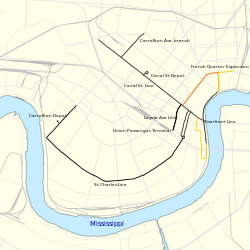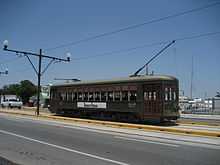New Orleans Regional Transit Authority
 | |
|---|---|
|
RTA building on Canal Street | |
| Founded | 1983 |
| Headquarters | New Orleans, Louisiana |
| Service area | City of New Orleans and Orleans Parish, Louisiana |
| Service type |
Public Transit Heritage streetcar |
| Routes |
30 (bus) 5 (streetcar) |
| Stops |
2154 (bus) 286 (streetcar) |
| Annual ridership | 18,634,500+ (2013) |
| Fuel type |
Diesel (bus) Electric (streetcar) |
| Operator | Transdev |
| Website | |


The New Orleans Regional Transit Authority (RTA or NORTA) is a public transportation agency based in New Orleans, Louisiana. Since 1983 it has operated bus and historic streetcar service throughout the city. With an annual ridership of over 18.6 million riders,[1] the Regional Transit Authority is the largest public transit agency in the state of Louisiana.
History
The oldest component of the RTA is the St. Charles streetcar line. It began in 1835 as a passenger railway between New Orleans and a suburb called Carrollton, which has since been absorbed into the city. The St. Charles line was one of the first passenger railroads in the country, and it remains the oldest continuously operating street railway in the world.
As the city grew, so did the transportation network. In the nineteenth and early twentieth centuries, several different private streetcar companies operated various lines throughout New Orleans. They competed with one another, which ended up creating inconsistent service for the public and costly inefficiencies for their owners. In the 1920s, the New Orleans city government formed an organization called New Orleans Public Service Incorporated (NOPSI), to consolidate not only public transit but also competing electricity and gas companies. NOPSI has since become Entergy New Orleans.
By the 1960s, buses had replaced many streetcar lines in New Orleans. Worried that an important part of the city's heritage would be lost, preservationists succeeded in listing the St. Charles line on the National Register of Historic Landmarks in 1973. Because of this special status, all the green St. Charles streetcars need to appear and be maintained and operated as they were in 1920.
In the first part of the last century, utility companies across the country were often in charge of operating their city's public transit systems, but these companies began to prefer focusing on providing power and looked to divest themselves of the public transport function. NOPSI was no exception. As a result, the Louisiana State Legislature established the Regional Transit Authority in 1979. After a transition period, in 1983 the RTA became fully responsible for operating and maintaining all city bus routes and the St. Charles streetcar line. The RTA established the Riverfront streetcar line in 1988 and revived the Canal Streetcar line in 2004.
In 2005, Hurricane Katrina swept through the city, damaging the city's levees and causing catastrophic flooding. The flooding destroyed most of the RTA's vehicles and facilities. Although recovery remains ongoing, the RTA has made tremendous progress in reviving its streetcar lines and bus routes, including replacing its bus and paratransit fleet with new buses, thereby making the city's fleet one of the newest in the country. Improved operations, on-time performance, maintenance and safety have led to dramatic increases in ridership. In addition, the agency has won grants and raised capital for a series of new projects, including new streetcar service along Loyola Avenue between Canal Street and the Union Passenger Terminal as well as for the neighborhoods around the French Quarter.
Part of the RTA's renaissance includes higher environmental standards. Our new buses run on bio-diesel, which emits much lower levels of CO2 and other emissions when compared to standard diesel fuel. Tires are filled with nitrogen which better maintains tire pressure and leads to improved fuel efficiency. As always, streetcars are powered by overhead electrical lines, resulting in even lower net emissions than gasoline-powered vehicles.
Hurricane Katrina
City buses were used before Hurricane Katrina hit to transport people to a refuge of last resort, the Louisiana Superdome. Much of the city flooded due to the storm. The NORTA Administration building on Plaza Drive appears to have been in ten feet of water. Almost eighty-five percent of the fleet was rendered useless and inoperative; 146 city buses were visible outdoors in the flood at the 2817 Canal St. facility, while only 22 were at 3900 Desire Pky. The 8201 Willow St. facility was one block within the flood but was built above street level. The buses at the flooded facilities were mostly written off.
All but one of the streetcars built in the 1990s and 2000s were severely damaged in the flooding resulting from the hurricane. The historic Perley Thomas-built streetcars of the St. Charles line were undamaged in the disaster. The damaged streetcars, which had been built by hand on the property by local workers, were repaired in the same facility with components from Brookville Equipment Co.[2]
Post-disaster recovery
As of 2007, service was restored to certain areas as they become habitable again. However, there is no 24-hour service on any bus or streetcar line, except for the St. Charles streetcar line. Streetcars were returned to the full length of Canal St. and the Riverfront, initially using the historic St. Charles Line streetcars, which had not been damaged, as had the red Canal cars. In 2008, the St. Charles streetcar resumed running the entire length of its route. By early 2009, the red Canal streetcars were repaired and had taken over service on the Canal and Riverfront Lines. The buses that have been restored to operation have returned to several major thoroughfares, including Elysian Fields Avenue, Esplanade Avenue, Claiborne Avenue, St. Claude Avenue, Judge Perez Drive, General Meyer Avenue, Lapalco Boulevard, Robert E. Lee Boulevard, and the Chef Menteur Highway. And just a few express routes, Morrison Express, Lake Forest Express and Read-Crowder Express, all serving Eastern New Orleans, have been reinstated so far.
A year before Katrina, in addition to local and express bus service, NORTA brought Bus Rapid Transit to the city. The first BRT line opened up on Broad Street, with two more lines opening up months later running along Tulane Avenue and Saint Claude Avenue.
Bus & Streetcar Route List
- 2 Riverfront Streetcar
- 5 Marigny-Bywater
- 10 Tchoupitoulas
- 11 Magazine
- 12 St. Charles Streetcar
- 15 Freret
- 16 S. Claiborne
- 27 Louisiana
- 28 M.L. King
- 32 Leonidas/Orleans-Treme
- 39 Tulane
- 45 Lakeview
- 47 Canal Streetcar to Cemeteries
- 48 Canal Streetcar to City Park/Museum
- 49 Loyola/UPT Streetcar
- 51 St. Bernard - Paris Ave.
- 52 St. Bernard - St. Anthony
- 55 Elysian Fields
- 57 Franklin
- 60 Hayne
- 62 Morrison Express
- 63 New Orleans East Owl
- 64 Lake Forest Express
- 65 Read-Crowder Express
- 80 Desire-Louisa
- 84 Galvez
- 88 St. Claude
- 90 Carrollton
- 91 Jackson-Esplanade
- 94 Broad
- 100 Algiers Owl
- 101 Algiers Point
- 102 General Meyer/Whitney
- 106 Aurora Local
- 108 Algiers Local
- 114 General DeGaulle - Sullen
- 115 General DeGaulle - Tullis
- 201 Kenner Loop
- 408 Algiers Local-L.B. Landry
RTA Governance
The body in charge of making major decisions for the RTA is the Board of Commissioners. The board consists of appointees by the Mayor of New Orleans and of some appointees by the President of Jefferson Parish. The RTA Board has the overall authority for transit in New Orleans including setting fares, overseeing service and operations, developing operating budgets, approving each year's annual transportation development plan, and deciding upon capital purchases and expansions. Under contract to the RTA Board of Commissioners, a company called Transdev Services manages all day-to-day aspects of the transit agency on behalf of the RTA Board. Transdev handles operations and service, safety issues, vehicle maintenance, customer care, route design and scheduling, human resources, administration, ridership growth, capital planning, grant administration, communications, purchasing, and other agency functions. Transdev is under contract to and reports to the RTA Board of Commissioners. The company operates public transportation for some 5,000 transit authorities around the world. This unique partnership between a public agency and the private sector gives the RTA's customers the best of both worlds. A board that is accountable to elected leaders controls policies, budgets and overall direction, while riders benefit from the cost effectiveness, efficiencies and expertise of a private sector organization.
See also
- Streetcars in New Orleans
- List of light-rail transit systems
References
- ↑ http://www.apta.com/resources/statistics/Documents/Ridership/2013-q4-ridership-APTA.pdf PUBLIC TRANSPORTATION RIDERSHIP REPORT - Fourth Quarter 2013
- ↑
External links
| ||||||||||||||||||||||||||
